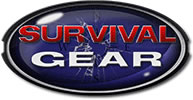Disaster Supply Kit
Various government agencies, including FEMA and the Department of Homeland Security, strongly advise citizens to assemble disaster supply kits in their homes. Authorities recognize that even with the best of intentions and plans, they likely won't be able to render assistance for at least a few day after a major disaster. As we saw in the aftermath of Hurricane Katrina, it could be a week or more before federal and state agencies are able to get help out to people affected by a disaster.
What should be in a disaster supply kit?
Water: Enough to last your entire family for at least three days. Experts recommend at least one gallon per person, per day. This supply could consist of purchased bottled water or water you've stored yourself in clean bottles or containers. Several retailers sell large water storage containers in their camping or sporting good departments. Water is heavy so don't buy a container so large you won't be able to move it easily.
Food: Again, the recommendation is to have at least a three day supply.
The food for your disaster supply kit should be non-perishable and require little or no preparation prior to eating. Remember, during a power outage you could still use a propane or charcoal grill for warming food. But, you probably won't want to try cooking a five course meal with this method. Stick to canned goods you can just reheat before eating, such as pasta, vegetables, soup, and stew.
First aid: Every disaster supply kit should have at least basic first aid supplies such as adhesive bandages, burn cream, antibiotic ointment, and pain relievers (ibuprofen, aspirin, etc.). You'll want things you can use to take care of simple cuts and scrapes. Consider also adding your preferred medications for stomach upset and fever. Also, be sure you have a good supply of any prescription medications your family members require on a regular basis, such as for heart problems or diabetes.
Tools: Most disasters you're preparing for will be weather related, such as blizzards, tornadoes, or ice storms. Odds are good that you may need tools and gear for dealing with windblown debris and/or downed trees. Therefore, a good chainsaw with extra chains and fuel would be a wise investment. Don't forget eye and ear protection as well as heavy duty work gloves. Bow saws, rope, and loppers are also good to have on hand for this type of emergency. Plastic sheeting and tarps may be used to cover broken windows. Duct tape has, of course, multiple uses.
Hygiene: If your water isn't running, you may find your toilets won't flush. Pick up either a camp toilet or a five gallon bucket with a lid to use until service is restored. If you go with the bucket, you can use kitty litter or sand to soak up the liquid waste and make it easier to handle. In a pinch, you can just line the toilet with a plastic garbage bag, then tie it closed after a few uses. Make sure you have a supply of toilet paper and/or baby wipes for cleaning up, as well as plenty of hand sanitizer.
Many homes already have most or all of the things needed for a disaster supply kit. But, you should do an inventory from time to time to ensure you'll have what you'll need in the aftermath of a major disaster.
